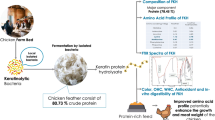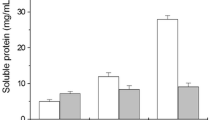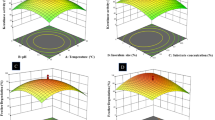Abstract
Accumulation of feather waste is becoming a major issue in solid waste management. Towards discovery of keratinolytic bacteria, screening of bacterial strains from feather dumping sites in North East, India was performed and 26 keratinolytic bacterial strains were isolated. Out of these, one isolate RCM-SSR-7 was found to be most promising strain exhibiting feather degradation as well as antioxidant and indole-3-acetic acid production. The strain was identified as Chryseobacterium sediminis RCM-SSR-7. The strain could use chicken feather as sole carbon and nitrogen source for growth. Three parameters (feather concentration, pH and incubation time) were studied to optimize feather protein hydrolysate (FPH) preparation using response surface methodology (RSM). The optimum condition for FPH preparation was achieved at 5% (w/v) feather concentration, pH 7.5, 30 °C and 84 h incubation time upon optimization by RSM. FPH was found to be rich in essential amino acids and trace elements (phosphorous, potassium, calcium, and iron). FPH exhibited radical scavenging activity with an IC50 value of 0.102 mg ml−1. In vitro digestibility showed that FPH is 86% digestible with pepsin and trypsin treatment. This study revealed that FPH produced by C. sediminis RCM-SSR-7 has the potential to be used as animal feed and organic fertilizer.




Similar content being viewed by others
References
Agrahari, S., Wadhwa, N.: Degradation of chicken feather a poultry waste product by keratiniolytic bacteria isolated from dumping site at Ghazipur poultry processing plant. Int. J. Poul. Sci.9, 482–489 (2010)
Xu, B., Zhong, Q., Tang, X., Yang, Y., Huang, Z.: Isolation and characterization of a new keratinolytic bacterium that exhibits significant feather-degrading capability. Afr. J. Biotechnol. 8, 4590–4596 (2009)
Sangali, S., Brandelli, A.: Feather keratin hydrolysis by a Vibrio sp. strain kr 2. J. Appl. Microbiol. 89, 735–743 (2000)
Papadopolous, M.C., El-Boushy, A.R., Roodbeen, A.E., Ketelaars, E.H.: Effects of processing time and moisture content on amino acids composition and nitrogen characteristics of feather meal. Anim. Feed Sci. Technol. 14, 279–290 (1986)
Steiner, R.J., Kellms, R.O., Church, D.C.: Feather and hair meals for ruminants. IV. Effects of chemical treatments of feathers and processing time on digestibility. J. Anim. Sci. 57, 495–502 (1983)
Park, G.T., Son, H.J.: Keratinolytic activity of Bacillus megaterium F7-1, a feather-degrading mesophilic bacterium. Microbiol. Res. 164, 478–485 (2009)
Moran, E., Summers, J., Slinger, S.: A source of protein for the growing chick. I. amino acid imbalance as the cause for inferior performance of feather meal. Poult. Sci. 45, 1257–1266 (1966)
Williams, C.M., Shih, J.C.H: Enumeration of some microbial groups in thermophilicn poultrywaste digesters and enrichment of a feather-degrading culture. J. Appl. Bacteriol. 67, 25–35 (1989)
Bertsch, A., Coello, N.: A biotechnological process for treatment and recycling poultry feathers as a feed ingredient. Bioresour. Technol. 96, 1703–1708 (2005)
Chew, B.P.: Importance of antioxidant vitamins in immunity and health in animals. Anim Feed Sci Technol. 59, 103–114 (1966)
Salami, S.A., Guinguina, A., Agboola, J.O., Omede, A.A., Agbonlahor, E.M., Tayyab, U.: Review: in vivo and postmortem effects of feed antioxidants in livestock: a review of the implications on authorization of antioxidant feed additives. Animal. 10, 1375–1390 (2016)
Fakhfakh, N., Ktari, N., Siala, R., Nasri, M.: Wool-waste valorization: production of protein hydrolysate with high antioxidative potential by fermentation with a new keratinolytic bacterium, Bacillus pumilus A1. J Appl Microbiol. 115, 424–433 (2013)
Choi, J.M., Nelson, P.V.: Developing a slow-release nitrogen fertilizer from organic sources: using poultry feathers. J. Am. Soc. Hortic. Sci. 121, 634–638 (1996)
Vesela, M., Friedrich, J.: Amino acid and soluble protein cocktail from waste keratin hydrolysed by a fungal keratinase of Paecilomyces marquandii. Biotechnol. Bioprocess. Eng. 14, 84–90 (2009)
Jeong, J.H., Lee, O.M., Jeon, Y.D., Kim, J.D., Lee, N.R.: Production of keratinolytic enzyme by a newly isolated feather-degrading Stenotrophomonas maltophilia that produces plant growth-promoting activity. Process Biochem. 45, 1738–1745 (2010)
Paul, T., Halder, S.K., Das, A., Bera, S., Maity, C.: Exploitation of chicken feather waste as a plant growth promoting agent using keratinase producing novel isolate Paenibacillus woosongensis. Biocatal. Agric. Biotechnol. 2, 50–57 (2013)
Kshetri, P., Ningthoujam, S.: Keratinolytic activities of alkaliphilic Bacillus sp. MBRL 575 from a novel habitat, limestone deposit site in Manipur, India. Springerplus. 5, 1–16 (2016)
Lowry, O.H., Rosebrough, N.J., Farr, A.L., Randall, R.J.: Protein measurement with the folin phenol reagent. J. Biol. Chem. 193, 267–275 (1951)
Cappuchino, J.G., Sherman, N.: Microbiology: a laboratory manual. Addison-Wesley Longman Inc, England (1999)
Kim, O.S., Cho, Y.J., Lee, K., Yoon, S.H., Kim, M., Park, S.C., Jeon, Y.S., Lee, J., Yi, H., Won, S., Chen, J.: Introducing EZ Taxon-e: a prokaryotic 16 S rRNA gene sequence database with phylotypes that represent uncultural species species. Int. J. Syst. Evol. Microbiol. 62, 716–721 (2012)
Tamura, K., Peterson, D., Peterson, N., Steche, R.G., Nei, M., Kumar, S.: MEGA5: molecular evolutionary genetics analysis using maximum likelihood, evolutionary distance and maximum parsimony and methods. Mol. Bio. Evol. 28, 2731–2739 (2011)
Bano, N., Musarrat, J.: Characterization of a new Pseudomonas aeruginosa strain NJ-15 as a potential biocontrol agent. Curr. Microbiol. 46, 324–328 (2003)
Thaipong, K., Boonprakob, U., Crosby, K., Cisneros-Zevallos, L., Byrne, D.H.: Comparison of ABTS, DPPH, FRAP, and ORAC assays for estimating antioxidant activity from guava fruit extracts. J. Food. Comp. Anal. 19, 669–675 (2006)
Jackson, M.L.: Soil Chemical Analysis Prentice Hall of India Private Limited, New Delhi, India (1973)
AOAC International Official methods of analysis of AOAC International. AOAC International, Gaithersburg, MD (1997)
Chapman, H. D., Pratt, P. F.: Methods of analysis for soils, plants and waters. Division of Agricultural Sciences, University of California, Riverside, USA (1961)
Bruckner, H., Wittner, R., Godel, H.: Fully automated high performance liquid chromatographic separation of DL amino acids derivatized with OPA together with N-isobutyrl-cystine, applications to food samples. Chromatographia. 32, 383–388 (1991)
Grazziotin, A., Pimentel, F.A., Jeong, E.V.D: Brandelli, A. Nutritional improvement of feather protein by treatment with microbial keratinase. Anim. Feed. Sci. Technol. 126, 135–144 (2006)
Gupta, R., Ramani, P.: Microbial keratinases and their prospective applications:an overview. Appl. Microbiol. Biotechnol. 70, 21–33 (2006)
Riffel, A., Lucas, F.S., Heeb, P., Brandelli, A.: Characterization of a new keratinolytic bacterium that completely degrades native feather keratin. Arch. Microbiol. 179, 258–265 (2003)
Hong, S.J., Park, G.S., Jung, B.K., Khan, A.R., Park, Y., Lee, C.H., Shin, J.H.: Isolation, identification, and characterization of a keratin-degrading bacterium Chryseobacterium sp. P1-3. J. Appl. Biol. Chem. 58, 247–251 (2015)
Gurav, R.G., Tang, J., Jadhav, J.P.: Sulfitolytic and keratinolytic potential of Chryseobacterium sp. RBT revealed hydrolysis of melanin containing feathers. 3 Biotech (2016). doi:10.1007/s13205-016-0464-0
Williams, C.M., Richter, C.S., Mackenzie, J.M., Shih, J.C.H.: Isolation identification and characterization of a feather degrading bacterium. Appl. Environ. Microbiol. 56, 1509–1515 (1990)
Brandelli, A.: Bacterial keratinases: useful enzymes for bioprocessing agroindustrial wastes and beyond. Food. Bioprocess. Technol. 1, 105–116 (2008)
Riffel, A., Dariot, D.J., Brandelli, A.: Nutritional regulation of protease production by the feather-degrading bacterium Chryseobacterium sp. kr6. New Biotechnol. (2011). doi:10.1016/j.nbt.2010.09.008
Suntornsuk, W., Suntornsuk, L.: Feather degradation by Bacillus sp. FK 46 in submerged cultivation. Bioresour. Technol. 86, 239–243 (2003)
Rajput, R., Gupta, R.: Thermostable keratinase from Bacillus pumilus KS12: production, chitin crosslinking and degradation of Sup35NM aggregrates. Bioresour. Technol. 133, 118–126 (2013)
Dutta, J.R., Dutta, P.K., Banerjee, R.: Optimization of culture parameters for extracellular protease production from a newly isolated Pseudomonas sp. using response surface and artificial neural network models. Process Biochem. 39, 2193–2198 (2004)
Manivasagan, P., Venkatesan, J., Sivakumar, K., Kim, S.K.: Production, characterization and antioxidant potential of protease from Streptomyces sp. MAB18 using poultry wastes. BioMed. Res. Int. (2013). doi:10.1155/2013/496586
Błaszczyk, A., Augustyniak, A., Skolimowski, J.: LEthoxyquin: an antioxidant used in animal feed. Int. J. Food Sci. (2013). doi:10.1155/2013/585931
Tiwary, E., Gupta, R.: Rapid conversion of chicken feather to feather meal using dimeric keratinase from Bacillus licheniformis ER-15. J. Bioprocess Biotechniq. 4, 1–5 (2012)
Onifade, A.A., Al-Sane, N.A., Al-Musallam, A.A., Al Zarban, S.: A review: potentials for biotechnological applications of keratin-degrading microorganisms and their enzymes for nutritional improvement of feathers and other keratins as livestock feed resources. Bioresour. Technol. 66, 1–11 (1998)
Dastager, S.G., Deepa, C.K., Pandey, A.: Isolation and characterization of novel plant growth promoting Micrococcus sp NII-0909 and its interaction with cowpea. Plant Physiol. Biochem. 48, 987–992 (2010)
Bhange, K., Chaturvedi, V., Bhatt, R.: Ameliorating effects of chicken feathers in plant growth promotion activity by a keratinolytic strain of Bacillus subtilis PF1. Bioresour. Bioprocess. 13, 2–10 (2016)
Acknowledgements
The authors gratefully acknowledges the award of DBT-Research Associateship by Department of Biotechnology (DBT), Government of India, which facilitated the completion of this research work. Authors also acknowledge Shankara Nethrayala, Chennai, India for providing amino acid analysis.
Author information
Authors and Affiliations
Corresponding author
Ethics declarations
Conflict of interest
The authors declare that they have no conflict of interest.
Rights and permissions
About this article
Cite this article
Kshetri, P., Roy, S.S., Sharma, S.K. et al. Transforming Chicken Feather Waste into Feather Protein Hydrolysate Using a Newly Isolated Multifaceted Keratinolytic Bacterium Chryseobacterium sediminis RCM-SSR-7. Waste Biomass Valor 10, 1–11 (2019). https://doi.org/10.1007/s12649-017-0037-4
Received:
Accepted:
Published:
Issue Date:
DOI: https://doi.org/10.1007/s12649-017-0037-4




